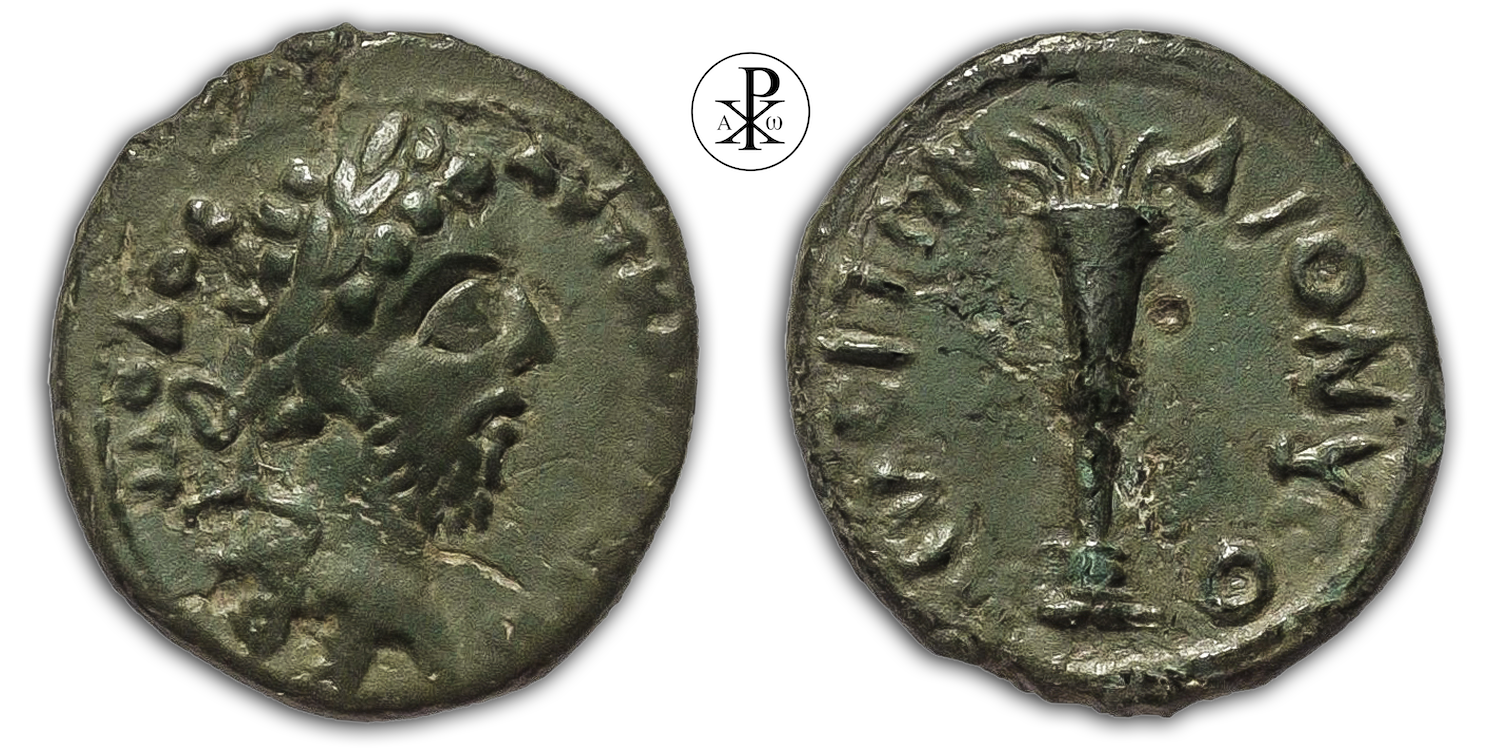Imperator Caesar Marcus Aurelius Commodus Antoninus Augustus
Reign: Commodus
Mint: Dionysopolis, Moesia Inferior
Date: 180/192 AD
Nominal: Bronze
Material: AE
Diameter: 17mm
Weight: 2.54g
Reference: RPC IV.1 4552
RPC Online: https://rpc.ashmus.ox.ac.uk/coins/4/4552
Rare: Specimens 7 (0 in the core collections)
Provenance: Solidus Numismatik Munich, Germany (Auction 116, Lot 114)
Pedigree: –
Obverse: Laureate head of Commodus, right
Inscription: ΑΥΤ ΚΑΙ Μ ΑΥΡΗ [ΚΟΜΟΔΟϹ]
Translation: Autokrator Kaisaros Marcos Aurelios Komodos
Translation: Imperator Caesar Marcus Aurelius Commodus
Reverse: Burning torch
Inscription: ΔΙΟΝΥϹΟΠΟΛƐΙΤΩΝ
Translation: Dionysopoleiton
Translation: City and People of Dionysopolis
Comment: Dionysopolis (or Dionysupolis or Dionysoupolis) was a town of ancient Thrace, later of Moesia Inferior, on the river Ziras. Today it is Balchik, Bulgaria, a Black Sea seaside resort town. It was founded as a Thracian settlement in was founded still in 5th century BC but was later colonised by the Ionian ancient Greeks and given the name Cruni or Krounoi. It was named Krounoi from the nearby founts of water. It was renamed as Dionysopolis after the discovery of a statue of Dionysus in the sea. In the beginning of 3rd century BC, the city was relatively independent and included in the system of fortifications built by Diadohite. One of the most important discoveries in borders of the ancient Dionysopolis is the Temple of Greet mother-goddess Cybele. Many of the artifacts found there can be seen today in Balchik History Museum (https://balchikmuseum.bg/en/temple-of-cybele). In the Roman period, Dionysopolis struck coins from Antoninus Pius to Gordian III. Most of the coin types from Dionysopolis are scarce or rare.
In antiquity, the torch was used in the cult of the dead, in ceremonial, as illumination (it was used to mark nocturnal events in pictures), as a signal and as an instrument of „embarrassing questioning“. Torches were used at the deathbed, they were carried in triumphal processions, and they were also used as a pictorial representation of light, fire, flame and fire (also as a weapon). But torches were also attributes of certain saints, mythological persons of antiquity and personifications – such as Dionysus on the bronze coin shown here. At least this can be assumed, if one assumes the name of the city and the special circumstance of its naming.
The ritual use of the torch and the cathartic and apotropaic effects attributed to it were the reason in antiquity for attaching the torch to deities in whose service they were commonly used, especially the gods of the Eleusinian and Dionysian cults as well as Hecate and the deities of her circle. Over time, the attribute was used to explain the meaning and function of the deities. Ceres lit her torch on the fire of Etna when she searched for her stolen daughter Proserpina for 9 days; Diana asked Jupiter to allow her to carry a torch and lit a wood as a torch on Jupiter’s thunderbolt on the mystic Olympus; Hecate defeated her opponent Clytius with her torch in the battle against the giants; Iolaus helped Hercules in the battle against the Lernaean Hydra by burning out the stumps of the beast’s neck with a torch to prevent the heads from growing back; Prometheus lit the fire on the wheel of the sun chariot; he used a torch for this; Hecuba dreamt before the birth of Paris that she was giving birth to a torch that would burn down Troy – and many other examples.
Torches are also common in the cult of Dionysus / Bacchus; they denote the state of exaltation and rapture at the approach of the god (RAC vol. 7 p. 168; depictions of bacchantes with torches are common). On an ancient cut stone reproduced by Montfaucon ([27] vol. 1, 2 p. 239 and pl. 150), he himself wields the wedding torch at Ariadne; how he came by this attribute could not be determined. The daughters of Minyas were transformed into bats by Bacchus; smouldering torches and the chambers were seen to glow with fire (Ovid, Met. IV, 402f.; cf. fig. 5). If Bacchus hands the torch to Cupid, this signifies the effect of wine on love. Comus, who belongs to the circle around Bacchus, stands drunkenly asleep at night at the door of the bridal chamber, a lowered torch in his right hand (Philostratus the Elder, Images I, 2). Schmieder interprets the lowered torch as a symbol of carefree joy. Ancient depictions of the „Satyr Game“ on vases and other objects are also known, showing the torch race of the young satyrs around Dionysus.
